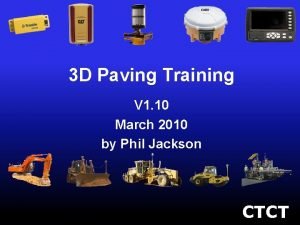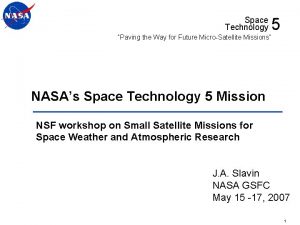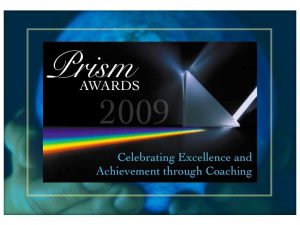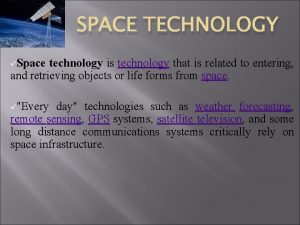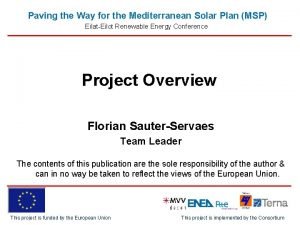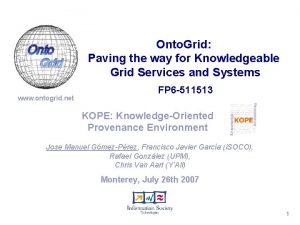Space Technology 5 Paving the Way for Future













- Slides: 13

Space Technology 5 “Paving the Way for Future Micro-Satellite Missions” NASA’s Space Technology 5 Mission NSF workshop on Small Satellite Missions for Space Weather and Atmospheric Research J. A. Slavin NASA GSFC May 15 -17, 2007 1

Pathfinder for Magnetospheric Constellation 2

ST 5 Mission Overview • NASA New Millennium Program mission to flightvalidate new concepts and technologies • Design and build 25 kg spacecraft: - Design, develop, integrate, test and operate three full service spacecraft, through the use of breakthrough technologies and provide a roadmap (written report). Integrate and validate technologies. • Research-quality spacecraft: - Demonstrate the ability to achieve accurate, researchquality scientific measurements utilizing a constellation of 3 micro-satellites. • Constellation Operations: - Execute the design, development, test and operation of multiple spacecraft to act as a single constellation rather than as individual elements. 3

ST-5 Spacecraft • Developed by GSFC in-house • Description - 3 spin-stabilized (~20 rpm) micro-spacecraft - Mass 25 kg (each) - ~50 cm x 48 cm 8 -sided spacecraft - Integral card cage structure (for C&DH, PSE) - Cold Gas Propulsion (10 m/s) - Intended to fly as “secondary” to GTO - Launched on Pegasus to 300 x 4500 km (105. 6 deg) • Key performance parameters - Spin axis knowledge – 0. 2 deg; Control - 0. 5 deg - 25 W Triple Junction Solar Array (29% Efficiency) - 5 V bus with new generation Lithium Ion Battery - X-band up/down 1 – 100 kbps - Onboard science event triggers and data storage - Magnetically Clean S/C (< 1 n. T achieved) - Radiation Qualified to 100 krad • Science & Operations demonstration - Research-grade miniature flux-gate magnetometer (UCLA) - “Lights-Out” totally autonomous operations for several weeks 4

ST 5 New Millennium Program Technologies • CULPRi. T Micro-Thruster • Transponder Power System incorporating a Lithium-Ion Battery and triple-junction solar cells: Provide s/c power - Battery effective Capacity = 7. 5 A-h (to 6 Vdc C/2 discharge) - Solar array beginning of Life Electrical output per panel (30 o. C, 1 Sun Air-Mass Zero): load voltage = 10. 2 Vdc, current = 1. 16 amps Microthruster: Used for attitude maintenance and Delta-V maneuvers to constellation formations - • Low Voltage Power System Autonomous Operations • Uplink rate 1 kbps; Downlink rate 1 kbps and 100 kbps. Average bit error rate (BER) of less than 1 x 10 -5 for each downlink pass. Radiation and latch-up tolerant Used as Reed Solomon encoder Operating voltage of 0. 5 V Variable Emittance Thermal Coatings: Thermal control demonstration - Variable Emittance Coatings Thrust greater than 2. 1 N at 2000 psi, and greater than 0. 1 N at 100 psi. Complimentary Metal Oxide Semiconductor, Ultra Low Power Logic (CULPRi. T): Low-voltage CMOS technology - • Specific impulse greater than 60 sec. X-Band Transponder: Provides coherent uplink and downlink - • Can be operated in pulse and continuous fire modes Range of emissivity variation 0. 4 to 0. 6 Software Tools for Autonomous Ground Operations: Perform model-based constellation health and safety management and provide efficient constellation management with a high degree of automation. 5

ST 5 Mission Profile • Launched March 22, 2006 - Pegasus out of Vandenberg - Approximately 10 min after launch, ejected 3 min apart Frisbee-style • Mission Duration: 90 days - 7 day launch & early orbit period - Mission completed June 20, 2006 • Orbit - 105. 6 deg inclination (full sun orbit) - ~ 300 km perigee; ~ 4500 km apogee - 136 minute period • Communications: Deep Space Network, Mc. Murdo Ground Station • Constellation Configuration: "String of Pearls" 6

Research-quality Science Demonstration • ST 5 validated the constellation concept by the measurement of important physical parameters that cannot be determined by single spacecraft • Formation fly in pre-determined configuration over the Earth’s northern and southern auroral zones (position uncertainty < 1 km) • Returned research-grade magnetometer measurements from a suitable platform • Measured auroral current sheet motion and thickness, electric current density, and temporal stability using the ST-5 constellation data 7

ST-5 Field-aligned Current Observations “Slow” “Typical” “Rapid” Rate of Field-Aligned Current Sheet Change (10 s – 10 min) 8

ST 5 Observations of Magnetization of Earth’s Crust – 2/2 Along-Track Gradient of the Crustal Magnetic Field 2006 Day 091 Start UT: 0200 First Micro-spacecraft Gradiometer Measurements Green: SC 094 Observations Red: Comprehensive model (CM 4) Model Prediction 9

ST 5 Autonomous Operations • Data Return Statistics - Overall data return rate: 94. 13% (94. 44% ENG data, 91. 93% MAG data) • SC 094: 91. 74% • SC 155: 93. 68% • SC 224: 94. 13% - Data return rate during AUTO OPS demonstration week: 81. 31% (86. 40% ENG, 76. 22% MAG) • SC 094: 73. 67% • SC 155: 84. 34% • SC 224: 84. 54% 10

Summary Remarks Space Technology 5 demonstrated the functionality of micro-satellites for Space Weather applications. Technical Highlights: • Autonomous Operations Test (> 80% data recovery) • Power Systems – 5 Volt bus • CULPRIT Low Voltage Rad Hard Reed-Solomon Encoder • Miniature X-Band Transponder (1 – 100 kbps) • Propulsion (10 m/s) • LEO Magnetic Fields Science Validation Primary Disappointment: • Could not obtain a secondary launch from any source within our 2 year launch window (except Ariane) 11

Technology Transfer • Space Technology 5 Technology Symposium was held on September 13, 2006 (CD Proceedings is ITAR Controlled – please contact Candace Carlisle [candace. carlisle@nasa. gov] for more information; see also nmp. nasa. gov). • Space Technology 5 open literature articles can be found in major Aerospace Journals and Meetings Proceedings. • Preparations are underway for Special ST-5 Section of Geophysical Research Letters. 12

Thank You! 13
 Future continuous tense rules
Future continuous tense rules Future simple continuous perfect
Future simple continuous perfect High desert aggregate and paving
High desert aggregate and paving Rsa paving
Rsa paving Illinois bituminous paving conference
Illinois bituminous paving conference Nchrp 23-24
Nchrp 23-24 D norman paving
D norman paving Branscome paving company
Branscome paving company Sutter paving
Sutter paving Relative frequency two way table
Relative frequency two way table Perbedaan one way dan two way anova
Perbedaan one way dan two way anova One way and two way threaded binary tree
One way and two way threaded binary tree Perbedaan one way anova dan two way anova
Perbedaan one way anova dan two way anova Anova test
Anova test






